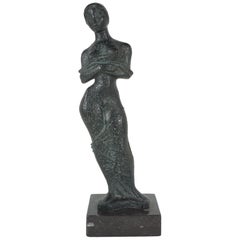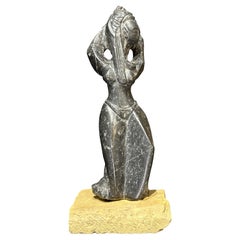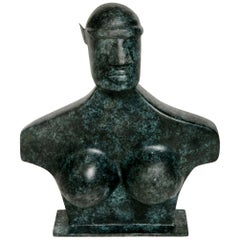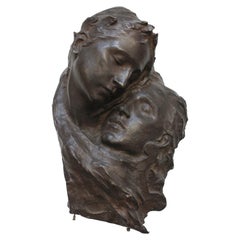Georges Oudot Sculptures
to
2
2
2
1
1
1
1
1
1
1
1
2
2
Height
to
Width
to
2
2
2
2
366
269
246
199
Creator: Georges Oudot
Cast Bronze Figure by Georges Oudot “Femme Debout Au Drape"
By Georges Oudot
Located in Hudson, NY
this work by famed Sculpture and Painter Georges Oudot was cast circa 1955 and bears his signature and the mark EA indicating its an artist proof, the foundry stamp of Susse Fondeur Paris. Entitled “Femme Debout au Drape” the work is dynamic and powerful as are almost all of the artist's figural works in bronze. The figure is cast and retains its original patina in a dark black-green. The artist's hand and the textural nature of his work are clearly evident in this piece. He was born in France in 1928 in Chaumont in the Haute-Mare. He attended the Besancon School of Fine Arts then in 1946 joined the Ecole des Beaux-Arts in Paris and studied under such artists as Marcel Gimond...
Category
Mid-20th Century French Modern Georges Oudot Sculptures
Materials
Bronze
Georges Oudot - Sculpture en Marbre fossile noir
By Georges Oudot
Located in NEUILLY-SUR-SEINE, FR
Rare Sculpture en Taille Directe sur Marbre Fossile Noir
Type : Sculpture en taille directe
Matériaux : Marbre fossile noir, base en pierre
Date de création : Circa 1950-1960
Dimens...
Category
1950s French Art Deco Vintage Georges Oudot Sculptures
Materials
Stone
Related Items
Femme Hermes Bronze Sculpture
Located in Houston, TX
A contemporary post modern patinated bronze "Femme Hermes" sculpture, unsigned.
Category
20th Century North American Post-Modern Georges Oudot Sculptures
Materials
Bronze
Fortini Cast Bronze Figural Relief Sculpture
Located in Brooklyn, NY
Cast hollow bronze figural sculpture carved in relief (ca. early 20th Century Italy). No chips or losses; light patina throughout. Masterful work and appealing subject matter. Can be...
Category
Early 20th Century Italian Art Nouveau Georges Oudot Sculptures
Materials
Bronze
Antique Figural Italian Cast Bronze Cat (circa 1920s)
Located in London, GB
Antique figural Italian cast bronze cat (circa 1920s). This Italian marvel, born in the heart of the 1920s, is not just a statue; it's a portal to a by...
Category
1920s Italian Vintage Georges Oudot Sculptures
Materials
Bronze
$1,090 Sale Price
20% Off
H 52.37 in W 7.68 in D 4.53 in
Antique Cast Bronze Elephant Figural Statue Sculpture on Marble Base
Located in San Diego, CA
Great cast bronze elephant sculpture mounted on a marble base. Elephant has wonderful details and appears the tusks were replaced over time. Base has one tiny edge chip. Elephant has...
Category
Early 20th Century Georges Oudot Sculptures
Materials
Bronze
$1,320 Sale Price
20% Off
H 9.25 in W 11.5 in D 4.75 in
Vintage Boho Cast Bronze Figure of David
Located in West Palm Beach, FL
A powerful and iconic vintage sculpture, this piece is a masterful reproduction after the celebrated 1872 masterpiece "David" by French sculptor Antonin Mercié. Cast in metal with a ...
Category
Mid-20th Century French Neoclassical Georges Oudot Sculptures
Materials
Bronze
George Kafka Kinetic Sculpture
Located in West Palm Beach, FL
Great movement on this kinetic Brutalist sculpture
Signed.
Category
1960s American Vintage Georges Oudot Sculptures
Materials
Metal
Pierre Bonnard 'Femme Nue Debout Bras Leves Derriere La Tete..' Alva Repro
By Pierre Bonnard
Located in Sharon, CT
Cast from the original "Femme Nue Debout Bras Leves Derriere La Tete, S'epongeant La Nuque" Bronze in The Albright Art Gallery. Published by Alva Reproductions. A rare reproduction ...
Category
Mid-20th Century American Modern Georges Oudot Sculptures
Materials
Plaster
$750
H 11.75 in W 4.75 in D 4.5 in
19th Century Animalier French Bronze Entitled "Taureau Debout" by Rosa Bonheur
By Rosa Bonheur
Located in London, GB
"Taureau Debout" by Rosa Bonheur.
An excellent late 19th Century French animalier bronze study of a standing bull with fine hand chased surface that accentuates the muscle definition of the subject, signed Rosa B.
ADDITIONAL INFORMATION
Measures: Width: 32 cm
Height: 18 cm
Depth: 11cm
Condition: Excellent Original Condition
Circa: 1870
Materials: Bronze
Book reference: Animals in Bronze by Christopher Payne
Page no. 174
DESCRIPTION
Bonheur, Rosa (1822-1899)
The most popular artist of nineteenth-century France, Rosa Bonheur was also one of the first renowned painters of animals and the first woman awarded the Grand Cross by the French Legion of Honor. A professional artist with a successful career, Bonheur lived in two consecutive committed relationships with women.
Born on March 16, 1822 in Bordeaux, Marie Rosalie Bonheur was the oldest of the four children of Raimond Oscar Bonheur (1796-1849) and Sophie Marquis. Bonheur's father was an art teacher who came from a poor family, while her mother, a musician, had descended from a middle-class family and had been her husband's art student.
Bonheur's father, who taught drawing and landscape painting, was an ardent member of the utopian Saint Simeon society.
The group held idealistic beliefs about the reform of work, property, marriage, and the role of women in society. Most importantly, for the artist's future, the Saint Simeons questioned traditional gender norms and firmly believed in the equality of women. While teaching artistic techniques to his oldest daughter, Raimond Bonheur also encouraged her independence and taught her to consider art as a career.
In 1828 Raimond Bonheur joined the Saint Simeons at their retreat outside Paris. Sophie and the children joined him in Paris the following year. Four years later, however, Raimond abandoned his family to live in isolation with his fellow Saint Simeons.
Sophie Bonheur died in 1833 at the age of thirty-six. Rosa was only eleven years old when her mother died, but she was aware of the heavy price her mother paid for married life with a man who was more dedicated to his own ideals than to meeting his family's needs. Rosa also saw that her mother's marriage led to poverty and her death from exhaustion.
After her mother's death, Bonheur was taken in by the Micas family who resided nearby. Mme Micas and Bonheur's mother had been friends. When Mme Bonheur died, the Micas family paid Raimond Bonheur's debts and cared for Rosa. Their daughther, Nathalie, who would later become an amateur inventor and unschooled veterinarian, and Rosa became enamored with each other.
When Rosa Bonheur began her career as a professional artist, she had already been trained by her father who had allowed her to study in all male classes. Rosa also learned by sketching masterworks at the Louvre from the age of fourteen, and later, by studying with Léon Cogniet.
From the very beginning, Bonheur's favorite subject was animals. She learned their anatomy completely by dissecting them in local slaughterhouses. She also visited the horse market two times a week. Study of animals by direct observation led to the formation of the realist style in which Bonheur worked.
It was for such work that Bonheur obtained written permission from the French government to wear men's slacks. Her working attire also consisted of a loose smock and heavy boots that protected her feet from the dangerous environment in which she painted. The style of dress that the artist adopted for work and home may well have been influenced by her father's attire, which was based on St. Simeonian clothing experiments. Bonheur also cropped her hair, perhaps to facilitate her work. She did, however, always wear dresses for social occasions because she knew that appropriate dress would further her career.
Bonheur earned a successful living as a painter of animals. She exhibited at the annual Paris Salon regularly from the age of nineteen in 1841 through 1853, when she was thirty-one. She won the salon's gold medal at the age of twenty-six in 1848 and was commissioned by the French government to paint Plowing on the Nivernais in 1849. In the same year Bonheur and her sister Juliette became directors of l'École gratuite de dessin pour les jeunes filles, a post their father had once held.
Bonheur completed her most renowned work, The Horse Fair, in 1855. The successful representation of percherons (a breed native to Normandy) was purchased by Ernest Gambart, a London art dealer whose gallery specialized in work by French artists. He exhibited The Horse Fair in London where Bonheur visited with Nathalie. Queen Victoria requested a private viewing of the painting at Windsor Castle. It would later be purchased in 1887 by Cornelius Vanderbilt and donated to the new Metropolitan Museum of Art in New York City.
Bonheur's trip to England allowed her to meet Charles Eastlake, then President of the Royal Academy, John Ruskin, the English writer and critic, and Edwin Landseer, the British animalier. She also toured the English and Scottish countrysides and executed some paintings based on her observations of new breeds of animals found there.
Gambart made engravings of Bonheur's work, including The Horse Fair, and sold them in England, Europe, and the United States. Bonheur became one of the most renowned painters of the time. Little girls, such as Anna Klumpke in the United States, even had dolls in her likeness, much as American girls played with Shirley Temple dolls...
Category
19th Century French Art Nouveau Antique Georges Oudot Sculptures
Materials
Bronze
$6,819
H 7.09 in W 13 in D 4.34 in
Art Deco bronze panther sculpture by Georges Lavroff, numbered, 1935.
By Georges Lavroff
Located in Antwerp, BE
Art Deco bronze panther sculpture by Georges Lavroff.
Signed G. Lavroff in the bronze,
Stamped number, 9133.
Patinated bronze on a Belgian Black marble base.
France 1935.
This pa...
Category
1930s French Art Deco Vintage Georges Oudot Sculptures
Materials
Belgian Black Marble, Bronze
$12,549
H 9.06 in W 24.02 in D 3.55 in
“Femmes au livre” Art Deco Sculpture Signed Godard, Circa 1920
By Armand Godard
Located in Beirut, LB
The sculpture "Femmes au Livre" by the artist Godard, depicting two women seated together, engrossed in a shared book. The figures are dressed in historically styled attire with deta...
Category
Mid-20th Century French Art Deco Georges Oudot Sculptures
Materials
Marble, Metal, Bronze
Georges H. Laurent Signed Art Deco Period Two Seagulls Bronze Sculpture, 1930
By Georges H. Laurent
Located in Miami, FL
Green patina bronze sculpture featuring two seagulls, signed G H LAURENT.
Reveyrolis Paris, France, 1930.
Category
20th Century French Art Deco Georges Oudot Sculptures
Materials
Marble, Bronze
$3,900
H 13 in W 34 in D 9 in
Nice Mid 19th Century Patinated Bronze Figure of a Woman Cast by Alfred Daubrée
By Alfred Daubrée
Located in Long Island City, NY
A Nice Mid 19th Century Patinated Bronze Figure of a Woman Cast by Alfred Daubrée
Attributed to Charles Cumberworth and Cast by Alfred Daubrée
Depicting a beautiful woman in robes ...
Category
Mid-19th Century French Belle Époque Antique Georges Oudot Sculptures
Materials
Bronze
$6,500
H 18 in W 11 in D 7 in
Georges Oudot sculptures for sale on 1stDibs.
Georges Oudot sculptures are available for sale on 1stDibs. These distinctive items are frequently made of metal and are designed with extraordinary care. There are many options to choose from in our collection of Georges Oudot sculptures, although brown editions of this piece are particularly popular. Many of the original sculptures by Georges Oudot were created in the modern style in france during the mid-20th century. If you’re looking for additional options, many customers also consider sculptures by Guylaine Guy, Yaacov Agam, and Andrée & Michel Hirlet. Prices for Georges Oudot sculptures can differ depending upon size, time period and other attributes — on 1stDibs, these items begin at $1,850 and can go as high as $8,750, while a piece like these, on average, fetch $5,300.



